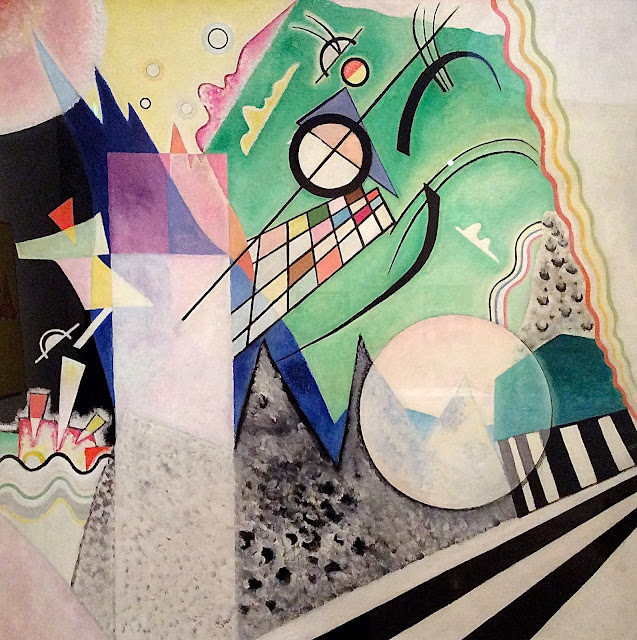Pasadena is the home of one of the world's greatest private art collections: The Norton Simon Museum. It's a wonderful thing when an ambitious and successful businessman turns his attention to art. He collects art with the same systematic and aggressive approach that he uses in business, and he has so much money to put into play. And then, the most wonderful part is that he feels an urge, a necessity, to share his treasure with the general public. And the result is that for a mere $12 adult admission, any ordinary person can live like royalty for an afternoon, experiencing one masterpiece after another. Norton Simon said that an art museum is like a substitute for a church, and I agree: a place to worship beauty, truth, and creativity.
As you enter the parking lot (parking is free), this dominating work by Barbara Hepworth, one of the foremost sculptors of the mid-20th century, announces that this place is about Art.
You might recognize the museum's façade: it is the first building on the route of the Rose Parade down Colorado Boulevard.
As you enter the parking lot (parking is free), this dominating work by Barbara Hepworth, one of the foremost sculptors of the mid-20th century, announces that this place is about Art.
 |
| Barbara Hepworth Four-Square (Walk-Through), 1966 I took this photo and all the photos in this post with my iPad |
The grounds of the museum features some extraordinary trees.
The front garden has several important works by Auguste Rodin, the foremost sculptor of the late 19th and early 20th century.
 |
| Auguste Rodin, 1840-1917 Saint John the Baptist, 1878-1880 |
 |
| A serpentine waterway complements the shape of the museum. Across the pond is a sculpture by Maillol. |
 |
| Aristide Maillol, 1861-1944 The Mountain, 1937 |
 |
| Ancient tree trunk has a sculptural quality. |
 |
| This smoke tree complements the brick facing. |
 |
| This sculpture by Henry Moore blends in with the tree behind it. |
 |
| Henry Moore, 1898-1986 Draped Reclining Woman, 1957-58 |
 |
| Henry Moore, 1898-1986 Family Group #1, 1949 |
 |
| Aristide Maillol, 1861-1944 Three Nymphes, 1930-1937 |
 |
| Barbara Hepworth, 1902-1975 Assembly of Sea Forms, 1972 |
 |
| James Whistler, 1834-1903 Arrangement in Grey and Black No. 1 (Portrait of the Artist’s Mother), 1871 |
 |
| Édouard Manet, 1832-1883 Émile Zola, 1868 |
 |
| Paul Cézanne, 1839-1906 The Card Players, c. 1892-1896 |
 |
| Paul Cézanne, 1839-1906 Vase of Flowers, 1880-81 |
 |
| Henri Fantin-Latour, 1836-1904 White and Pink Mallows in a Vase, 1895 |
 |
| Claude Monet, 1840-1926 The Artist’s Garden at Vétheuil, 1881 |
 |
| Camille Pissarro, 1830-1903 The Poultry Market at Pontoise, 1882 |
 |
| Vincent van Gogh, 1853-1890 The Mulberry Tree, 1889 |
 |
| Vincent van Gogh, 1853-1890 Portrait of the Artist’s Mother, 1888 |
 |
| Pierre Bonnard, 1867-1947 Portrait of Leila Claude Anet, 1930 |
 |
| Vasily Kandinsky, 1866-1944 Open Green, 1923 |
 |
| Vasily Kandinsky, 1866-1944 Heavy Circles, 1927 |
 |
| Henri Matisse, 1869-1954 Nude on a Sofa, 1923 |
 |
| Pablo Picasso, 1881-1973 Woman with a Book, 1932 |
 |
| Diego Rivera, 1886-1957 The Flower Vendor (Girl with Lilies), 1941 |
Here are a few outstanding works from the 1700s. Notice how polished they look, as though the human hand were not involved.
 |
| François Boucher, 1703-1770 The Beautiful Country Woman, c. 1732 |
 |
| Elisabeth Vigée-Lebrun, 1755-1842 Theresa, Countess Kinsky, 1793 |
 |
| Marie-Geneviève Bouliar, 1763-1825 Self-Portrait, 1792 |
 |
| Jean-Auguste-Dominique Ingres, 1780-1867 Baron Joseph-Pierre de Mortatieu, 1805 |
 |
| Rembrandt van Rijn, 1606-1669 Portrait of a Bearded Man in a Wide-Brimmed Hat, 1633 |
 |
| Rembrandt van Rijn, 1606-1669 Self-Portrait, c. 1636-1638 |
 |
| Baciccio, 1639-1709 St. Joseph and the Infant Christ, c. 1680 |
 |
| Jan Brueghel the Younger, 1601-1678 Flowers in a Gilt Tazza, c. 1620 |
 |
| Rachel Ruysch, 1664-1750 Nosegay on a Marble Plinth, c. 1695 |
 |
| Peter Paul Rubens, 1577-1640 The Holy Women at the Sepulchre, c. 1611-1614 |
 |
| Frans Hals, 1580-1666 Portrait of a Young Man, 1650-1655 |
 |
| Jacopo Bassano, 1510-1592 The Flight into Egypt, c. 1544-1545 |
 |
| Jan Massys, 1509-1575 Susanna and the Elders, 1564 |
 |
| Botticelli, 1444-1510 Madonna and Child with Adoring Angel, c. 1468 |
 |
| Raphael, 1483-1520 Madonna and Child with Book, c. 1502-03 |


